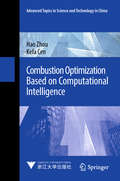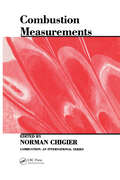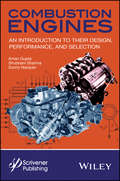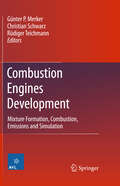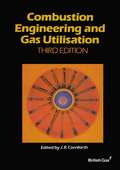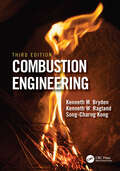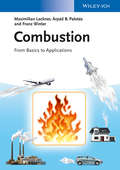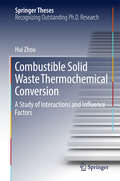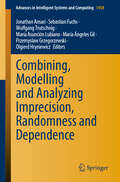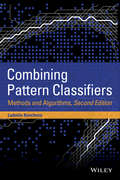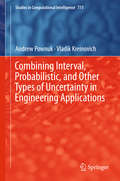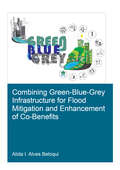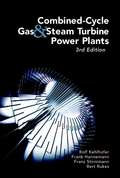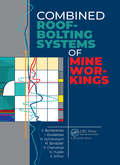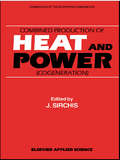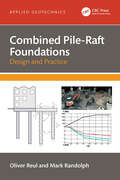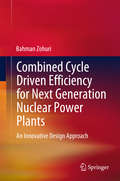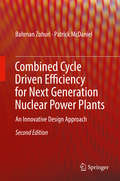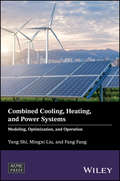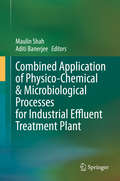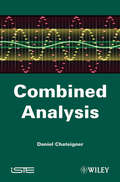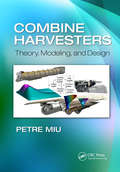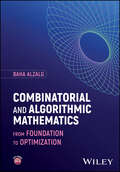- Table View
- List View
Combustion Optimization Based on Computational Intelligence (Advanced Topics in Science and Technology in China)
by Hao Zhou Kefa CenThis book presents the latest findings on the subject of combustion optimization based on computational intelligence. It covers a broad range of topics, including the modeling of coal combustion characteristics based on artificial neural networks and support vector machines. It also describes the optimization of combustion parameters using genetic algorithms or ant colony algorithms, an online coal optimization system, etc. Accordingly, the book offers a unique guide for researchers in the areas of combustion optimization, NOx emission control, energy and power engineering, and chemical engineering.
Combustion Measurements
by Norman ChigierThe book begins with an introduction to the general problems of making measurements in high temperature and a presentation of chemically reacting flow systems. It describes each instrument with the various diagnostic techniques and discusses measurements that have been made in furnaces, flames, and rocket engines. The detailed measurement techniques described in this book cover a wide spectrum of applications in combustion systems, including gas turbine, rocket measurement techniques that were developed in laboratories. Information obtained on detailed temperature, velocity, particle size, and gas concentration distribution is leading to improve understanding of the chemical combustion process and to design imporvements in combustors.
Combustion Engines: An Introduction to Their Design, Performance, and Selection
by Aman Gupta Shubham Sharma Sunny NarayanVehicle noise, vibration, and emissions are only a few of the factors that can have a detrimental effects on overall performance of an engine. These aspects are benchmarks for choice of customers while choosing a vehicle or for engineers while choosing an engine for industrial applications. It is important that mechanical and automotive engineers have some knowledge in this area, as a part of their well-rounded training for designing and selecting various types of engines. This volume is a valuable introductory text and a handy reference for any engineer, manager, or technician working in this area. The automotive industry, and other industries that make use of engines in their industrial applications, account for billions, or even trillions, of dollars of revenue worldwide and are important in the daily lives of many, if not most, of the people living on this planet. This is an area that affects a staggering number of people, and the information needed by engineers and technicians concerning the performance of various types of engines is of paramount importance in designing and selecting engines and the processes into which they are introduced.
Combustion Engines Development: Mixture Formation, Combustion, Emissions and Simulation
by Christian Schwarz Günter P. Merker Rüdiger TeichmannCombustion Engines Development nowadays is based on simulation, not only of the transient reaction of vehicles or of the complete driveshaft, but also of the highly unsteady processes in the carburation process and the combustion chamber of an engine. Different physical and chemical approaches are described to show the potentials and limits of the models used for simulation.
Combustion Engineering and Gas Utilisation
by British GasCombustion Engineering & Gas Utilisation is a practical guide to sound engineering practice for engineers from industry and commerce responsible for the selection, installation, designing and maintenance of efficient and safe gas fired heating equipment.
Combustion Engineering
by Kenneth W. Ragland Kenneth Bryden Song-Charng KongCombustion Engineering, Third Edition introduces the analysis, design, and building of combustion energy systems. It discusses current global energy, climate, and air pollution challenges and considers the increasing importance of renewable energy sources, such as biomass fuels. Mathematical methods are presented, along with qualitative descriptions of their use, which are supported by numerous tables with practical data and formulae, worked examples, chapter-end problems, and updated references. The new edition features new and updated sections on solid biofuels, spark-ignition, compression-ignition, soot and black carbon formation, and current energy policies. Features include: Builds a strong foundation for design and engineering of combustion systems. Provides fully updated coverage of alternative and renewable fuel topics throughout the text. Features new and updated sections on solid biofuels, spark-ignition, compression-ignition, soot and black carbon formation, and current energy policies. Includes updated data and formulae, worked examples, and additional chapter-end problems. Includes a Solutions Manual and figures slides for adopting instructors. This text is intended for undergraduate and first-year graduate mechanical engineering students taking introductory courses in combustion. Practicing heating engineers, utility engineers, and engineers consulting in energy and environmental areas will find this book a useful reference.
Combustion
by Maximilian Lackner Árpád Palotás Franz WinterCombustion, the process of burning, is defined as a chemical reaction between a combustible reactant (the fuel) and an oxidizing agent (such as air) in order to produce heat and in most cases light while new chemical species (e.g., flue gas components) are formed. This book covers a gap on the market by providing a concise introduction to combustion. Most of the other books currently available are targeted towards the experienced users and contain too many details and/or contain knowledge at a fairly high level. This book provides a brief and clear overview of the combustion basics, suitable for beginners and then focuses on practical aspects, rather than theory, illustrated by a number of industrial applications as examples. The content is aimed to provide a general understanding of the various concepts, techniques and equipment for students at all level as well as practitioners with little or no prior experience in the field.The authors are all international experts in the field of combustion technology and adopt here a clear didactic style with many practical examples to cover the most common solid, liquid and gaseous fuels. The associated environmental impacts are also discussed so that readers can develop an understanding of the major issues and the options available for more sustainable combustion processes.With a foreword by Katharina Kohse-Höinghaus
Combustible Solid Waste Thermochemical Conversion: A Study of Interactions and Influence Factors (Springer Theses)
by Hui ZhouThis book is written by Dr. Hui Zhou as a Ph. D. dissertation in Tsinghua University, China. It establishes the thermochemical characteristics of model compounds in combustible solid waste (CSW), and delineates the influence of different factors on the thermochemical characteristics and the influence interactions between model components have on the thermochemical characteristics. The works provide a theoretical basis for the clean and high-efficiency utilization of CSW as well as the basic knowledge for further understanding the thermochemical conversion mechanisms of complex fuels. Researchers and engineers in the field of thermal engineering and environmental engineering can benefit from the book.
Combining, Modelling and Analyzing Imprecision, Randomness and Dependence (Advances in Intelligent Systems and Computing #1458)
by Sebastian Fuchs María Ángeles Gil Olgierd Hryniewicz Przemyslaw Grzegorzewski Wolfgang Trutschnig María Asunción Lubiano Jonathan AnsariThis volume contains more than 65 peer-reviewed papers corresponding to presentations at the 11th Conference on Soft Methods in Probability and Statistics (SMPS) held in Salzburg, Austria, in September 2024. It covers recent advances in the field of probability, statistics, and data science, with a particular focus on dealing with dependence, imprecision and incomplete information. Reflecting the fact that data science continues to evolve, this book serves as a bridge between different groups of experts, including statisticians, mathematicians, computer scientists, and engineers, and encourages interdisciplinary research. The selected contributions cover a wide range of topics such as imprecise probabilities, random sets, belief functions, possibility theory, and dependence modeling. Readers will find discussions on clustering, depth concepts, dimensionality reduction, and robustness, reflecting the conference's commitment to addressing real-world challenges through innovative methods.
Combining Pattern Classifiers
by Ludmila I. KunchevaCombined classifiers, which are central to the ubiquitous performance of pattern recognition and machine learning, are generally considered more accurate than single classifiers. In a didactic, detailed assessment, Combining Pattern Classifiers examines the basic theories and tactics of classifier combination while presenting the most recent research in the field. Among the pattern recognition tasks that this book explores are mail sorting, face recognition, signature verification, decoding brain fMRI images, identifying emotions, analyzing gene microarray data, and spotting patterns in consumer preference. This updated second edition is equipped with the latest knowledge for academics, students, and practitioners involved in pattern recognition fields.
Combining Interval, Probabilistic, and Other Types of Uncertainty in Engineering Applications (Studies In Computational Intelligence #773)
by Vladik Kreinovich Andrew PownukHow can we solve engineering problems while taking into account data characterized by different types of measurement and estimation uncertainty: interval, probabilistic, fuzzy, etc.? This book provides a theoretical basis for arriving at such solutions, as well as case studies demonstrating how these theoretical ideas can be translated into practical applications in the geosciences, pavement engineering, etc.In all these developments, the authors’ objectives were to provide accurate estimates of the resulting uncertainty; to offer solutions that require reasonably short computation times; to offer content that is accessible for engineers; and to be sufficiently general - so that readers can use the book for many different problems. The authors also describe how to make decisions under different types of uncertainty.The book offers a valuable resource for all practical engineers interested in better ways of gauging uncertainty, for students eager to learn and apply the new techniques, and for researchers interested in processing heterogeneous uncertainty.
Combining Green-Blue-Grey Infrastructure for Flood Mitigation and Enhancement of Co-Benfits (IHE Delft PhD Thesis Series)
by Alida I Alves BeloquiAn increment of urban flood risk in many areas around the globe is expected, accentuated due to climate change and urbanisation. Thus, appropriate flood risk management is crucial. Conventional approaches focus on grey infrastructure, which frequently do not address the root causes of risk. A change of paradigm is needed to develop effective adaptation strategies. Green-blue infrastructure (GBI) is a central concept to achieve adaptation to climate change. Its main strength is the ability to deliver multiple benefits. Although strong evidence exists demonstrating that GBI is a sustainable solution to reduce flooding, its adoption is still slow. Therefore, the objective of this research is to help decision-makers to adopt adaptation strategies to cope with flood risk while achieving other benefits. This study provides a framework which introduces co-benefits into decision-making for stormwater infrastructure planning. Besides, the multiple benefits are quantified and their impact on helping GBI implementation are evaluated. Finally, the effects of including co-benefits on the selection of flood mitigation strategies and the trade-offs among cost and benefits are assessed. This work contributes to enhance planning processes for flood mitigation combining green-blue-grey measures. It provides tools and knowledge to facilitate holistic decision-making, in order to ensure safe and liveable urban spaces for current and future conditions.
Combined-Cycle Gas & Steam Turbine Power Plants
by Rolf Kehlhofer Bert Rukes Frank Hannemann Franz StirnimannWith this third edition, international expert Rolf Kehlhofer leads a team of eminent engineers for the long awaited update of the "bible" for combined-cycle plants.Combined-Cycle Gas & Steam Turbine Power Plants, 3rd Edition, is a comprehensive overview of the combined-cycle power plant from a thermodynamic, technical, and economic viewpoint. This new edition gives readers the latest technological developments and practical examples from existing, state-of-the-art combined-cycle plants. Both practicing engineers and engineering students will find this book the definitive work on combined-cycle power plants.
Combined Theoretical and Experimental Study of Ice Behavior Under Shock and Explosive Loads (SpringerBriefs in Applied Sciences and Technology)
by Maxim Yu. Orlov Yulia N. OrlovaThe book presents theoretical and experimental studies of ice fracturing process during impact and explosion load. It shows how to obtain ice in natural and artificial conditions. The book summarizes the results of full-scale experiments for 5 years on undermining ice sheets with emulsion explosives. It presents an algorithm that simulates the process of fracturing of thick ice subjected to blast load, showing that the behavior of ice under impact and explosive loads can be described by a model of continuum mechanics. Qualitative and quantitative assessments of the ballistic perfomance of an ice cube after deep penetration low-velocity projectiles are reported in this book. Some pilot problems are formulated for a deeper understanding of the mechanics of ice fracturing during impact and explosion.
Combined Roof-Bolting Systems of Mine Workings
by V. Bondarenko, I. Kovalevska, H. Symanovych, M. Barabash, V. Chervatiuk, O. Husiev and V. SnihurThe basic principles of geomechanical processes occurring in mine workings during the extraction of minerals are discussed in this monograph. Particular attention is paid to the support system, specifically to the various roof-bolt and frame support designs, and also to the modern means providing resource-saving conditions for ensuring mine workings sustainability. The basic principles of the computing experiment performance at the modelling of geomechanical processes are also presented and the stress-strain state of "rock massif – mine working support" systems are investigated. Finally, the results of field studies are discussed and illustrated. Modern studies are presented in this work, the advanced support systems are introduced and the solution to the problem of low-cost rock pressure control in mine workings is described. Further the unique study in the thin-layer massif of weak rocks is conducted and the technical and economic aspects of mine workings maintenance during rocks heaving are described. The book will be of interest to scientists in research and design organizations in the mining sector, engineers and technological workers in mines, as well as university academics and students.
Combined Production of Heat and Power
by J. SirchisProceedings of a European seminar organized by the CEC, Directorate-General for Energy and the Instituto para la Diversificacion y Ahorro de la Energia Eua (IDEA) with the cooperation of Gomez Pardo Foundation's Energy Commission, Madrid, Spain, 10-11 October 1989.
Combined Pile-Raft Foundations: Design and Practice (Applied Geotechnics)
by Mark Randolph Oliver ReulThis book presents the fundamental features of the design and performance of combined pile-raft foundations (CPRFs). Whereas in a traditional foundation the loads are carried either by the raft or by the piles, the capacity of CPRFs is assessed for the foundation as a whole, reducing total and differential settlements economically.The five chapters provide an overview of the historical development of piled rafts in practice and research, and of the design concepts developed for piled rafts over the last decades. Fundamental aspects of their bearing behaviour are presented, as well as an overview of the framework of the design process for CPRFs, including the safety concept, the design approach summarised in the ISSMGE Combined Pile-Raft Foundation Guideline (ISSMGE TC 212 2013) and the interaction between structural and geotechnical engineering. For numerical analysis based on the finite element method, guidance is given on creating the model and performing the calculations before providing basic information on the requirements for the site investigation, supervision of the construction process and monitoring of the foundation performance. Detailed case studies illustrate the design and performance of CPRFs, and a design example for the foundation of a multi-storey office building founded in non-cohesive soil is investigated, carrying out 3D finite element analysis to estimate deformations and design parameters for structural engineering.Based on the combined experience of the authors obtained in the last decades working in the industry and research, the book particularly suits consulting engineers engaged in foundation engineering, as well as graduate students and researchers interested in the bearing behaviour of piled rafts and pile groups.
Combined Exposures to Hydrogen Cyanide and Carbon Monoxide in Army Operations: Initial Report
by National Research Council of the National AcademiesIn response to a request from the U.S. Army, a committee convened by the National Research Council (NRC) conducted the first in a sequence of studies evaluating the combined health effects of low-level exposure to two chemicals Army personnel are likely to be exposed to in firing tank weapons. The Army sought information on whether the two chemicals, hydrogen cyanide and carbon monoxide, result in similar health impacts and should be assessed together when establishing exposure limits. Based on a review of the scientific literature, the report finds that the biochemical health impacts of the chemicals are similar and that the Army's proposed approach to setting exposure limits is appropriate. Because previous research has focused on high exposures, this initial NRC report recommends that futher neurological studies at low concentrations of exposure to the chemicals be conducted.
Combined Cycle Driven Efficiency for Next Generation Nuclear Power Plants: An Innovative Design Approach
by Bahman ZohuriIntroduces the concept of combined cycles for next generation nuclear power plants, explaining how recent advances in gas turbines have made these systems increasingly desirable for efficiency gains and cost-of-ownership reduction. Promulgates modelling and analysis techniques to identify opportunities for increased thermodynamic efficiency and decreased water usage over current Light Water Reactor (LWR) systems. Examines all power conversion aspects, from the fluid exiting the reactor to energy releases into the environment, with special focus on heat exchangers and turbo-machinery. Provides examples of small projects to facilitate nuanced understanding of the theories and implementation of combined-cycle nuclear plants. This book explores combined cycle driven efficiency of new nuclear power plants and describes how to model and analyze a nuclear heated multi-turbine power conversion system operating with atmospheric air as the working fluid. The included studies are intended to identify paths for future work on next generation nuclear power plants (GEN-IV), leveraging advances in natural-gas-fired turbines that enable coupling salt-cooled, helium-cooled, and sodium-cooled reactors to a Nuclear Air-Brayton Combined Cycle (NACC). These reactors provide the option of operating base-load nuclear plants with variable electricity output to the grid using natural gas or stored heat to produce peak power. The author describes overall system architecture, components and detailed modelling results of Brayton-Rankine Combined Cycle power conversion systems and Recuperated Brayton Cycle systems, since they offer the highest overall energy conversion efficiencies. With ever-higher temperatures predicted in GEN-IV plants, this book's investigation of potential avenues for thermodynamic efficiency gains will be of great interest to nuclear engineers and researchers, as well as power plant operators and students.
Combined Cycle Driven Efficiency for Next Generation Nuclear Power Plants: An Innovative Design Approach
by Bahman Zohuri Patrick McDanielIntroduces the concept of combined cycles for next generation nuclear power plants, explaining how recent advances in gas turbines have made these systems increasingly desirable for efficiency gains and cost-of-ownership reduction. Promulgates modelling and analysis techniques to identify opportunities for increased thermodynamic efficiency and decreased water usage over current Light Water Reactor (LWR) systems. Examines all power conversion aspects, from the fluid exiting the reactor to energy releases into the environment, with special focus on heat exchangers and turbo-machinery. Provides examples of small projects to facilitate nuanced understanding of the theories and implementation of combined-cycle nuclear plants. This book explores combined cycle driven efficiency of new nuclear power plants and describes how to model and analyze a nuclear heated multi-turbine power conversion system operating with atmospheric air as the working fluid. The included studies are intended to identify paths for future work on next generation nuclear power plants (GEN-IV), leveraging advances in natural-gas-fired turbines that enable coupling salt-cooled, helium-cooled, and sodium-cooled reactors to a Nuclear Air-Brayton Combined Cycle (NACC). These reactors provide the option of operating base-load nuclear plants with variable electricity output to the grid using natural gas or stored heat to produce peak power. The author describes overall system architecture, components and detailed modelling results of Brayton-Rankine Combined Cycle power conversion systems and Recuperated Brayton Cycle systems, since they offer the highest overall energy conversion efficiencies. With ever-higher temperatures predicted in GEN-IV plants, this book's investigation of potential avenues for thermodynamic efficiency gains will be of great interest to nuclear engineers and researchers, as well as power plant operators and students.
Combined Cooling, Heating, and Power Systems: Modeling, Optimization, and Operation
by Yang Shi Fang Fang Mingxi LiuA comprehensive review of state-of-the-art CCHP modeling, optimization, and operation theory and practice This book was written by an international author team at the forefront of combined cooling, heating, and power (CCHP) systems R&D. It offers systematic coverage of state-of-the-art mathematical modeling, structure optimization, and CCHP system operation, supplemented with numerous illustrative case studies and examples. CCHP systems are an exciting emerging energy technology offering significant economic and environmental benefits. Combined Cooling, Heating, and Power Systems: Modelling, Optimization, and Operation is a timely response to ongoing efforts to maximize the efficiency of that technology. It begins with a survey of CCHP systems from the technological and societal perspectives, offering readers a broad and stimulating overview of the field. It then digs down into topics crucial for optimal CCHP operation. Discussions of each topic are carefully structured, walking readers from introduction and background to technical details. A set of new methodologies for the modeling, optimization and control of CCHP systems are presented within a unified framework. And the authors demonstrate innovative solutions to a variety of CCHP systems problems using new approaches to optimal power flow, load forecasting, and system operation design. Provides a comprehensive review of state-of-the-art of CCHP system development Presents new methodologies for mathematical modeling, optimization, and advanced control Combines theoretical rigor with real-world application perspectives Features numerous examples demonstrating an array of new design strategies Reflects the combined experience of veteran researchers in the field whose contributions are well recognized within the energy community Offers excellent background reading for students currently enrolled in the growing number of courses on energy systems at universities worldwide Timely, authoritative, and offering a balanced presentation of theory and practice, Combined Cooling, Heating, and Power Systems: Modelling, Optimization, and Operation is a valuable resource forresearchers, design practitioners, and graduate students in the areas of control theory, energy management, and energy systems design.
Combined Application of Physico-Chemical & Microbiological Processes for Industrial Effluent Treatment Plant
by Aditi Banerjee Maulin ShahIn recent decades, scientific insight into the chemistry of water has increased enormously, leading to the development of advanced wastewater and water purification technologies. However, the quality of freshwater resources has continually deteriorated worldwide, both in industrialized and developing countries. Although traditional wastewater technologies focus on the removal of suspended solids, nutrients and bacteria, hundreds of organic pollutants occur in wastewater and urban surface waters. These new pollutants are synthetic or naturally occurring chemicals that are not often monitored in the environment but have the potential to enter the environment and cause known or suspected adverse ecological and / or human health effects. Collectively referred to as the "emerging contaminants," they are mostly derived from domestic use and occur in trace concentrations ranging from pico to micrograms per liter. Environmental contaminants are resistant to conventional wastewater treatment processes and most of them remain unaffected, leading to the contamination of the receiving water. As such, there is a need for advanced wastewater treatment process that is capable of removing environmental contaminants to ensure safe fresh water supplies. This book explains the biological and chemical wastewater treatment technologies. The biological wastewater treatment processes presented include: (1) bioremediation of wastewater such as aerobic and anaerobic treatment; (2) phytoremediation of wastewater using engineered wetlands, rhizofiltration, rhizodegradation, phytodegradation, phytoaccumulation, phytotransformation and hyperaccumulators; and (3) mycoremediation of wastewater. The chemical wastewater treatment processes discussed include chemical precipitation, ion exchange, neutralization, adsorption and disinfection. In addition, the book describes wastewater treatment plants in terms of plant size, layout and design as well as installation location. Also presenting the latest, innovative effluent water treatment processes, it is a valuable resource for biochemical and wastewater treatment engineers, environmental scientists and environmental microbiologists.
Combined Analysis (Wiley-iste Ser.)
by Daniel ChateignerThis book introduces and details the key facets of Combined Analysis - an x-ray and/or neutron scattering methodology which combines structural, textural, stress, microstructural, phase, layer, or other relevant variable or property analyses in a single approach. The text starts with basic theories related to diffraction by polycrystals and some of the most common combined analysis instrumental set-ups are detailed. Also discussed are microstructures of powder diffraction profiles; quantitative phase analysis from the Rietveld analysis; residual stress analysis for isotropic and anisotropic materials; specular x-ray reflectivity, and the various associated models.
Combine Harvesters: Theory, Modeling, and Design
by Petre MiuFrom Basic Fundamentals to Advanced Design ApplicationsA culmination of the author's more than 20 years of research efforts, academic papers, and lecture notes, Combine Harvesters: Theory, Modeling, and Design outlines the key concepts of combine harvester process theory and provides you with a complete and thorough understanding of combine harvest
Combinatorial and Algorithmic Mathematics: From Foundation to Optimization
by Baha AlzalgDetailed review of optimization from first principles, supported by rigorous math and computer science explanations and various learning aids Supported by rigorous math and computer science foundations, Combinatorial and Algorithmic Mathematics: From Foundation to Optimization provides a from-scratch understanding to the field of optimization, discussing 70 algorithms with roughly 220 illustrative examples, 160 nontrivial end-of-chapter exercises with complete solutions to ensure readers can apply appropriate theories, principles, and concepts when required, and Matlab codes that solve some specific problems. This book helps readers to develop mathematical maturity, including skills such as handling increasingly abstract ideas, recognizing mathematical patterns, and generalizing from specific examples to broad concepts. Starting from first principles of mathematical logic, set-theoretic structures, and analytic and algebraic structures, this book covers both combinatorics and algorithms in separate sections, then brings the material together in a final section on optimization. This book focuses on topics essential for anyone wanting to develop and apply their understanding of optimization to areas such as data structures, algorithms, artificial intelligence, machine learning, data science, computer systems, networks, and computer security. Combinatorial and Algorithmic Mathematics includes discussion on: Propositional logic and predicate logic, set-theoretic structures such as sets, relations, and functions, and basic analytic and algebraic structures such as sequences, series, subspaces, convex structures, and polyhedraRecurrence-solving techniques, counting methods, permutations, combinations, arrangements of objects and sets, and graph basics and propertiesAsymptotic notations, techniques for analyzing algorithms, and computational complexity of various algorithmsLinear optimization and its geometry and duality, simplex and non-simplex algorithms for linear optimization, second-order cone programming, and semidefinite programming Combinatorial and Algorithmic Mathematics is an ideal textbook resource on the subject for students studying discrete structures, combinatorics, algorithms, and optimization. It also caters to scientists across diverse disciplines that incorporate algorithms and academics and researchers who wish to better understand some modern optimization methodologies.
